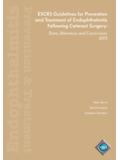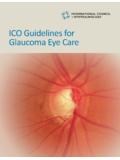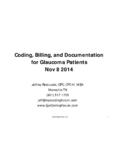Transcription of tis and Treatment of Endophthalmitis ESCRS …
1 ESCRS guidelines for Prevention and Treatment of EndophthalmitisFollowing Cataract Surgery: Data, Dilemmas and Conclusions2013 Prevention & TreatmentEndophthalmitisPeter BarryLuis Cordov sSusanne GardnerPeter Barry FRCS, FRCO phth, FRCSI,Consultant Ophthalmic SurgeonRoyal Victoria Eye and Ear and St Vincent s University HospitalDublin, IrelandLuis Cordov s MD Retina and Vitreous SectionOphthalmology ServiceHospital Universitario de Canarias, SpainSusanne Gardner D. in Ocular Pharmacology and PharmacokineticsAtlanta, Georgia, USAESCRS guidelines for Prevention and Treatment of EndophthalmitisFollowing Cataract Surgery: Data, Dilemmas and ConclusionsPublished by the European Society of Cataract and Refractive Surgeons, Temple House, Temple Road, Blackrock, Co Dublin, Ireland These guidelines are dedicated to Per Montan and colleagues at St Erik s Eye Hospital, Stockholm, Sweden.
2 They are the unsung heroes of intracameral antibiotic prophylaxis of Endophthalmitis following cataract OF CONTENTS1. INTRODUCTION 12. DEFINITION OF Endophthalmitis 13. PATHOPHYSIOLOGY OF POSTOPERATIVE Endophthalmitis 24. MICROBIAL SPECTRUM OF POSTOPERATIVE Endophthalmitis 2 Common sources of infection in postoperative Endophthalmitis 2 Commonly isolated microbial species in postoperative Endophthalmitis 3 Microbial spectrum of Endophthalmitis in the ESCRS study 3 Microbial spectrum of Endophthalmitis : recent reports 4 Methicillin-resistant S. aureus (MRSA) and S. epidermidis (MRSE), and increasing resistance to common topical antibiotics 55. INCIDENCE OF Endophthalmitis AFTER CATARACT SURGERY 7 Historical background Endophthalmitis rates 8 Reduced Endophthalmitis rates after initiation of intracameral antibiotic prophylaxis 86.
3 THE Endophthalmitis VITRECTOMY STUDY (EVS) 107. ESCRS STUDY ON PROPHYLAXIS OF Endophthalmitis AFTER CATARACT SURGERY 108. UPTAKE OF INTRACAMERAL CEFUROXIME AS PROPHYLAXIS OF POSTOPERATIVE Endophthalmitis 139. RISK FACTORS FOR POSTOPERATIVE Endophthalmitis IDENTIFIED IN THE ESCRS STUDY 1510. PREOPERATIVE ANTISEPSIS 1611. OPERATING THEATRE 1712. DIAGNOSIS AND Treatment OF ACUTE AND CHRONIC Endophthalmitis 18 Diagnosis 18 Microbiology testing 19 PCR 20 TASS vs Infectious Endophthalmitis 20 Treatment of acute postoperative Endophthalmitis 21 Chronic saccular Endophthalmitis 2413. INTRAVITREAL ANTIBIOTICS 2614. ADJUNCTIVE SYSTEMIC ANTIBIOTIC Treatment 2715.
4 DILEMMAS IN THE PREVENTION OF POSTOPERATIVE Endophthalmitis 28 Allergy to cefuroxime 28 Choice of postoperative drop regimen 29 Choice of intracameral injection, subconjunctival injection or topical drops 30 APPENDIX I PREPARATION OF INTRAVITREAL DOSES 31 APPENDIX II PHARMACOKINETICS and PHARMACODYNAMICS (PK/PD): 33 fundamentals for understanding antibiotic action in the eye REFERENCES AND BIBLIOGRAPHY 391 Endophthalmitis is a serious complication of cataract surgery that every ophthalmic surgeon - and patient - strives to avoid. The visual loss and debilitation that occur in a large proportion of postoperative Endophthalmitis cases can be severe and irreversible. Those most in need of the operation are often those at greatest risk, such as the elderly. Without knowing exactly how, when or why to intervene with effective prophylactic measures, virtually every surgeon today follows a standard of care that involves antisepsis and antibiotics.
5 Although cataract surgery ranks among the most frequently performed surgical procedures worldwide, data to define the most effective prophylactic measures have been nearly impossible to generate, given the large patient numbers needed to conduct clinical trials. Prevention and elimination of postoperative Endophthalmitis , however, is a constant goal of every ophthalmic clinical practice of administering a direct intracameral injection of cefuroxime at the close of cataract surgery to reduce Endophthalmitis rates was first implemented by a group of Swedish surgeons, to whom this edition of the guidelines is dedicated. The clinical benefit of this intervention seemed apparent. In order to test the hypothesis in a scientific manner, the European Society of Cataract and Refractive Surgeons mounted a large randomized clinical trial to evaluate the intracameral injection in a prospective, randomized fashion across nine European countries.
6 Results published in 2007 unequivocally demonstrated a clinical benefit, with a five-fold reduction in postoperative Endophthalmitis rates in patients who received a 1mg intracameral injection of cefuroxime at the close of cataract the wake of these results, a growing number of centres have adopted this method of prophylaxis, reporting even more striking effects, on occasion, than the ESCRS study itself. In parallel, scientific principles that underlie microbial eradication in the atypical spaces of the eye have been explored. These data and scientific principles are presented in an evidence-based manner in this publication of the ESCRS guidelines for Prevention and Treatment of Endophthalmitis following cataract 1 through 15 review etiology, microbiology and recent study reports, and present guidelines for prevention, diagnosis and Treatment of postoperative Endophthalmitis .
7 Appendix I presents instructions for preparing intravitreal injections and Appendix II provides an overview of pharmacokinetics/pharmacodynamics, the scientific principles that help us understand how bacteria may be eradicated in the atypical spaces of the eye. These fundamental principles support the rationale of the intracameral injection and help to navigate the literature on this essential topic. 1 INTRODUCTIONP ostoperative Endophthalmitis is an inflammatory condition of the eye, presumed to be due to an infectious process from bacteria, fungi or, on rare occasions, parasites that enter the eye during the perioperative period. Other forms of Endophthalmitis may arise from endogenous sources where septicaemia spreads to the internal eye, or from perforating injury to the eye from objects or organic matter, but these conditions involve clinical presentations and management guidelines substantially different from Endophthalmitis after cataract surgery.
8 Endophthalmitis following bleb procedures for the Treatment of glaucoma also comprises a spectrum of bacteria and management guidelines that differ from postoperative Endophthalmitis after cataract surgery. Exogenous Endophthalmitis may present in an acute, virulent form, or a more chronic, late Endophthalmitis . In these guidelines , we focus on the prophylaxis and management of the exogenous form of Endophthalmitis that occurs after cataract surgery, and where bacterial infection stems from contamination of the wound and internal eye in the perioperative environment. 2 DEFINITION OF Endophthalmitis 2 The severity and clinical course of postoperative Endophthalmitis is related to the virulence and inoculum of infecting bacteria, as well as time to diagnosis and the patient s immune status. The infectious process undergoes an initial incubation phase which may be clinically unapparent, lasting at least 16-18 hours, during which a critical load of bacteria proliferate and break down the aqueous barrier; this is followed by fibrin exudation and cellular infiltration by neutrophilic granulocytes.
9 The incubation phase varies with the generation time of the infecting microbe, (eg: up to 10 minutes for S. aureus and Ps. aeruginosa; over 5 hours for Propionibacterium spp.) along with other factors such as production of bacterial toxins. With common microorganisms such as S. epidermidis (CNS) as much as 3 days may lapse before the infiltration reaches its peak. An acceleration phase and, finally, a destructive phase of the infection develops. The acceleration phase follows primary infection of the posterior segment and leads to inflammation of the anterior chamber and an immune response with macrophages and lymphocytes infiltrating into the vitreous cavity within about 7 days. By 3 days after intraocular infection, pathogen-specific antibodies can be detected; these help to eliminate microbes through opsonisation and phagocytosis within about 10 days.
10 Consequently, laboratory results may prove negative while severe inflammation is occurring within the eye. Inflammatory mediators, especially cytokines, further recruit leucocytes, which may add to destructive effects, retinal injury and vitreoretinal proliferation. The infecting microorganisms in postoperative Endophthalmitis originate from environmental, climatic, surgical, and patient-specific factors, among others. In these guidelines , we focus on prophylaxis of Endophthalmitis after cataract surgery, and the microorganisms most commonly implicated in these intraocular SOURCES OF INFECTION IN POSTOPERATIVE ENDOPHTHALMITISThe etiology of microorganisms infecting the eye during cataract surgery include the following: the patient s own ocular surface flora [Speaker 1991, Bannerman 1997]. A majority of contaminants during, and even after, surgery can be traced to the patient s own ocular surface flora.





